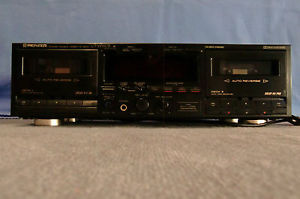Pioneer CT-W 550 R
Dates
General
- Manufacturer: Pioneer
- Model: CT-W 550 R'
- Type: Double
- Year of manufacture: 1991
- Made in: Japan
- Color: black
- Remote control: via system remote control
- Power consumption: 26 W
- Dimensions (W/H/D): 420 mm (W) x 128 mm (H) x 268 mm (D)
- Weight: 4.6 kg
- Original price approx.: DM 500,00
Connections
- recording line-in, cinch sockets, 63mV/68kOhm
- Playback Line-out, Cinch sockets, 316mV/3,1kOhm
- Control-In (remote control)
- Control-out (remote control)
- Headphones, 6.3mm jack 0.25mW/8Ohm
- CD deck syncro
Specifications
- Audio heads: 1x record/playback head, 1x playback head, 1x erase head
- Motors: 2x DC motor, 2x coil motor
- Synchronisation fluctuations: 0.055% (effective), +/- 0.16% (DIN)
- Belt types:
- Type I (standard band) 20 - 17,000 Hz.
- Type II (chrome band) 20 - 18,000 Hz
Type IV (metal band) 20 - 19,000 Hz
- Fast rewind time: about 90sec (C-60 band)
- Distortion factor: < 0,8%
- Signal-Rausch-Abstand:
- Dolby-Rauschunterdrückung OFF >57dB
- Noise reduction:
- Dolby B ON: > 10dB (at 5kHz).
Dolby C ON: > 19dB (at 5kHz)
- Auto Reverse: yes
- Title search: +/- 15 titles
- Dolby: HX PRO, B, C
- MPX filter: yes, linked to Dolby NR switch
- manual recording level control
- manual recording balance control
- CD sync recording: yes
Special Features
- synchronized dubbing start
- normal or high speed dubbing operation
- level meter with extended peak indicator
- automatic tape type switching
- 4-digit electronic tape counter/time counter on both decks
- Wake-up call playback/recording function
Remarks
Other models in the same series:
Pictures
Reviews
After some operating time the eject buttons of the decks jam, some oil helps.... The recording wake-up function (automatic start of recording when power is turned on) is good to control, otherwise it happens quickly that a cassette is simply over-recorded when you turn the unit on. The tape counter drive unfortunately always switches back from the time counter to the standard counter mode when the unit is switched off.
Links
</0,8%>
